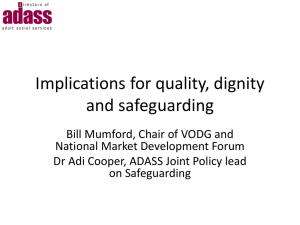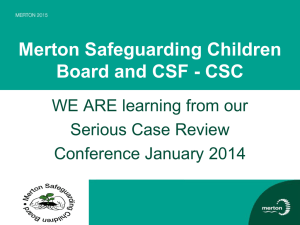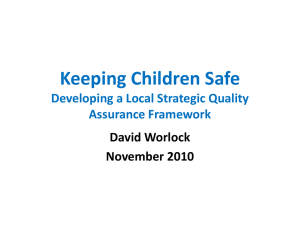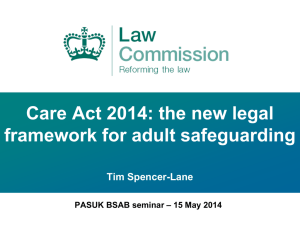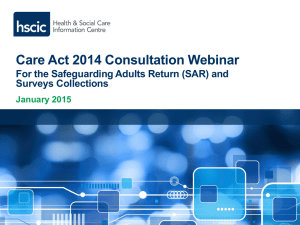The safeguarding aspects of the Care Act 2014 and
advertisement
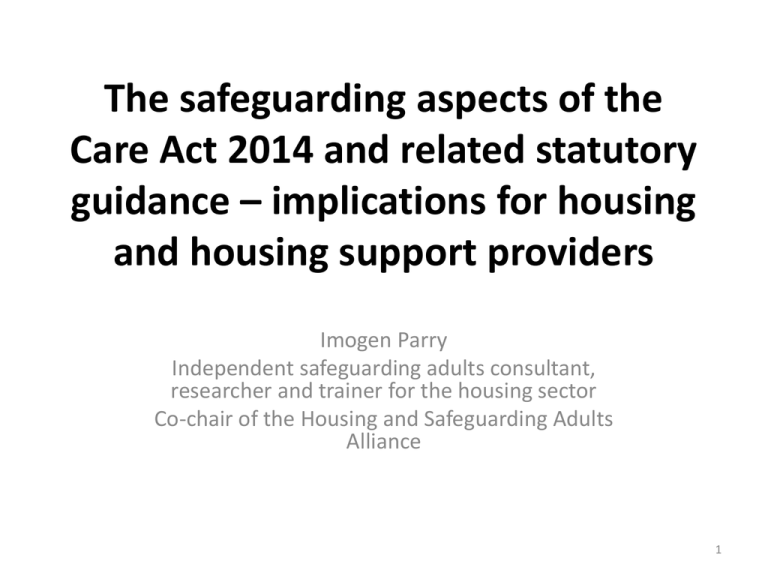
The safeguarding aspects of the Care Act 2014 and related statutory guidance – implications for housing and housing support providers Imogen Parry Independent safeguarding adults consultant, researcher and trainer for the housing sector Co-chair of the Housing and Safeguarding Adults Alliance 1 The limitations of ‘No Secrets’ 2000 • Statutory guidance – not legislation • Preceded the Mental Capacity Act 2005, much case law arising from the Human Rights Act 1998, DoLS • Referred to ‘vulnerable adults’ and ‘adult protection’ not ‘adult at risk’ or ‘safeguarding’ • Focus on processes and procedures, contributed to ‘risk aversion’ not personalisation or outcomes • Lack of clarity about differences between poor practice, abuse, crime • ‘Only’ sheltered and supported housing staff included 2 Statements of Government Policy on Adult Safeguarding • Issued in May 2011 and May 2013 • Set out adult safeguarding principles: – Empowerment – presumption of person led decisions and informed consent – Prevention – it is better to take action before harm occurs – Proportionality – proportionate and least intrusive response appropriate to the risk presented – Protection – support and representation for those in greatest need – Partnership – local solutions through services working with their communities. Communities have a part to play in preventing, detecting and reporting abuse – Accountability – accountability and transparency in delivering safeguarding 3 The Care Act 2014 - safeguarding sections 42 - 45 • New duty for local authority to carry out enquiries (or cause others to) where it suspects an adult is at risk of abuse or neglect. • Requirement for all areas to establish a Safeguarding Adults Board (SAB) • SABs to carry out safeguarding adults reviews (SARs) • New ability for SABs to require information sharing from other partners to support SARs or other functions. 4 The Care Act 2014 – other sections and guidance relevant to safeguarding adults • • • • • Well-being Co-operation Prevention focus Advocates Wide scope for what constitutes abuse or neglect • Self-neglect included in list of types of abuse for the first time 5 Does the Care Act go far enough to safeguard adults? (1) • The Care Act is a major improvement on ‘No Secrets’ • But there: • are resource concerns • is no power of entry or duty to report despite much lobbying and debate • may be insufficient ‘teeth’ for SABs to be effective 6 Does the Care Act go far enough to safeguard adults? (2) • is a lack of clarity about thresholds and sometimes an absence of systems for low level concerns • are insufficient references to the need to make links with other issues such as domestic abuse, hate crime and ASB • is a lack of clarity about consent issues 7 The Care Act draft statutory guidance for adult safeguarding – housing implications (1) • 14 references to housing providers, housing support providers • Agencies should identify a senior manager to take a lead role in organisational and inter-agency safeguarding arrangements • Although not a statutory member of SABs, housing providers and housing support providers may be invited • Housing support workers may be asked to ‘make enquiries’ 8 The Care Act draft statutory guidance for adult safeguarding – housing implications (2) • All housing providers and housing support providers should have clear operational policies and procedures in adult safeguarding • All housing staff must be: • familiar with the six principles underpinning adult safeguarding • trained in recognising the symptoms of abuse • vigilant and able to respond to adult safeguarding concerns 9




